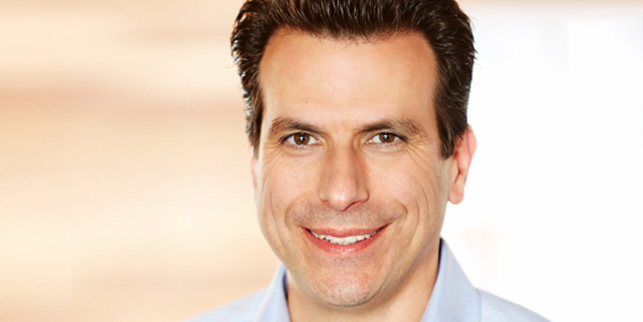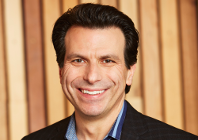
New Autodesk CEO Andrew Anagnost
In February, after being at Autodesk on and off for over 24 years, company CEO, Carl Bass, stepped down. Having run Autodesk since 2006, Bass changed the company culture to focus on product innovation, developing new code streams, addressing new design areas, with a focus on manufacturing.
The company’s business model also changed towards delivering services on the cloud with a move from perpetual licensing to subscription.
In June, long-time Autodesker Andrew Anagnost was announced as the new CEO.
Over the decades Anagnost has held various roles within Autodesk, including chief marketing officer and SVP of Business Development, and was also one of the original driving forces behind the development of Inventor, Autodesk’s first serious new code stream after AutoCAD.
Anagnost inherits a company with a buoyant share price and gets to continue with his business model of moving the $2.14 billion company to subscription and the cloud, but he can now obviously control all aspects, including product development direction.
D3D: You have come from both the mechanical and business side of the company, so which of the divisions is your natural passion?
Anagnost: I have a passion for solving really big problems. There’s no doubt that my background is in manufacturing but there are two areas I’m really excited about. One is construction – and I guess I am cheating a little bit here, as it’s industrialising and we have the opportunity to bring the BIM [Building Information Modelling] model into construction.
I think it’s an exciting opportunity for our customers and for Autodesk and one, frankly, where I feel that I have a really big value to add in terms of my knowledge in how things progress through manufacturing as models become more and more important.
The other area I have a lot of passion for is this idea of getting us to push button manufacturing.
I know it sounds whacky at the moment but five years from now we are going to be really close to being able to automate the process of having a really complicated 3D model, pushing a button and getting a part come out the other side from a multipurpose factory.
These are long-term passions, in the short-term I have more customer based objectives. I’m excited about subscriptions and collections. We aren’t there yet but I’m going to make sure that we get there.
D3D: Autodesk has divested itself of its 3D printer (Ember) and seems to be getting out of hardware, although you still have Pier 9 manufacturing facility. What’s the view on hardware now?
Anagnost: You remember the rise of desktop publishing? The world changed when Adobe came out with PostScript because what you saw is what you got coming out of the printer.
Our goal is to make sure that what you see is what you make and it’s much more important and valuable that we play the PostScript role in manufacturing than play a hardware vendor role.
So if we’ve got a dollar to spend we’re going to spend it on the development of PostScript and the new types of automation from manufacturing rather than building hardware.
Ember was a test bed of the technology so we could see how it worked and get experience with that. It was never going to be our mainline business.
D3D: With Autodesk subscriptions, you are asking customers to move from perpetual licences to subscription and some customers of your more mature products are concerned as to the value they are getting.
Anagnost: Our goal is to become a cloud company, which means our goal is to change our entire value chain with a different set of price points. I think in all the rough-andtumble of people talking about the “bad” thing we are doing, people are forgetting the good thing we are doing.
The maintenance base feels like we’re raising prices but a whole bunch of customers who [due to their purchasing experience of Autodesk products] think we’ve lowered prices.
It’s the whole Yin Yang of all of this. The original goal was to become a cloud company, with cloud price points all the way through our value chain.
D3D: For those customers who have signed an ELA [Enterprise Licence Agreement – lasts for three years for the biggest Autodesk customers], the price hikes are pretty steep. Subscription is asking firms new questions about how much they want to pay for their tools. It’s not business as usual.
Anagnost: I agree with you, I don’t think it’s business as usual. I think some customers are struggling with the pricing, but here’s the dichotomy I have put in front of me: Yes, our maintenance base is struggling with this, asking “what’s going on?” and “where is the value?”.
I talk to them and I even call the one-man shops, as well as the big guys, and I tell them consistently: I understand and I want you to give us a year to prove to you that we are delivering value.
If we don’t, leave us. I have this conversation over and over again but I have to juxtapose this with the hundreds of thousands of new seats that are coming in from people who have never bought from us before.
So our existing customers are deeply suspicious about what’s going on, but these new customers are emailing us saying you just put food on my family’s table.
You probably don’t see both sides of this. I see the difficult side and recognise all the work Autodesk needs to do to solve this and build trust. And then there’s the other side where we created a pool of trust… and if I can bring those two together then it’s a home run for everybody.
There is no doubt at all that the mechanical design industry is going to need a completely new class of tools in the additive and automated word. So Fusion is not going anywhere, it is going to get focussed a little bit more on this critical long term problem
D3D: What is your vision for Fusion?
Anagnost: With Fusion I want to narrow its focus a little bit. When I spoke earlier about solving this push button manufacturing problem, I think Fusion is the platform for doing that. It’s the platform for solving this flow from design to make and doing it in a highly automated way starting with this massive simplification but ultimately getting into automation.
So I am going to focus it a little bit more. Fusion is a long term player in the industry – there is no doubt at all that the mechanical design industry is going to need a completely new class of tools in the additive and automated word. So Fusion is not going anywhere, it is going to get focussed a little bit more on this critical long term problem.
D3D: Do you think the price of Fusion is still right? It’s pretty low at the moment.
Anagnost: Yes, the price is pretty low. Any customer that bought it at that price is always going to pay that price, that is just the way it is, but you’ve got to admit, look at what we’ve put into it.
On one side you’ve got existing customers complaining about the dollar value we are giving them and on the other side you’ve got this product that does nonlinear simulation for $300 a year.
There is a little bit of a discrepancy there and that’s got to be adjusted.
D3D: What’s your vision for route to market and resellers as changes to margins are reducing the number of value added resellers (VARs)?
Anagnost: The number of channel partners we have has dramatically decreased over the last three years. When you look at our business three years out and then five years out, we are going to be doing at least 50 per cent of our business through channel partners.
So we are still a channel company five years out – and by the way, that half of our business is bigger than the size of our current business today. So that means there is a huge role for VARs in our business. We do not sell word processing software, we sell sophisticated stuff.
The future of our partners falls into three segments.
Firstly, they’re going to be a collections channel because collections are what take our most complicated products to market.
Secondly, they’re going to be a consumption channel, which is going to become a powerful part of our portfolio where people are pushing buttons for one timevalue add and that’s going to be huge. And thirdly, they’re going to become third-party developers all over again.
They’re going to get back to where they were 30 years ago, customising what we do, but that will be on the Forge platform, not on the desktop.
There’s really no future any more for a partner that just sells AutoCAD or LT. It’s not where the business is going.
D3D: Will you be a hands-on CEO like Carl Bass was?
Anagnost: I’m pretty deep into just about everything this company does, which is a curse and a blessing for the people that work here.
Carl went deep a lot in product, I’m probably going to go deep in multiple things. I am going to go deep in the things I am passionate about – construction and push-button manufacturing, as mentioned before – but also go deep in the brand and deep into what the sales force is doing and how we are engaging with customers. So yes, I’m going to be pretty hands-on.
autodesk.com
An interview with Autodesk’s new CEO Andrew Anagnost
Default






